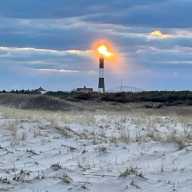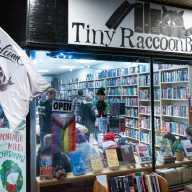By Emma Boskovski ~ The SeatuckEnvironmental Association’s John Turner gave a lecture on Wednesday,March 20, at 7 p.m., titled “Reflections on a Transparent Issue: The BillionDead Bird Problem.” The lecture was hosted at the Scully Estate at the SuffolkCounty Environmental Center in Islip. The purpose of the lecture was to focuson the causes of window-bird collisions that are of the top sources for birdmortality worldwide. Information regarding the advances in window productsdeveloped to suppress this issue also was discussed.
Turner, who focuses on policy andeducation in his work, began the lecture with the remark, “Birds are abarometer of human health.
“There are about10,000 different bird species,” Turner said. “About 40 percent of them are indecline. About 10-12 percent of those have declined to points of extinction.This underscores humanities collective impact on birds and biodiversity ingeneral.”
According to the American BirdConservancy, it is estimated that between 365 and 988 million birdsdie each year from collision incidents involving windows.
“I titled thislecture, ‘reflections on a transparent issue’ because I wanted to illustratethe two important characteristics that windows have: reflectivity andtransparency,” Turner said. “Because of this, birds cannot see thewindows.”
The AmericanBird Conservancy refers to glass as the “invisible killer” and attributescollisions with buildings to be the number one anthropogenic threat to birds.During the day, reflective windows can mirror the landscape surrounding themand clear glass creates an illusion for birds. At night, migrating birds can beattracted to well-lit structures and become disoriented. Both of thesecircumstances can lead to collisions.
“Most peopleconsider bird-glass collisions to be an urban phenomenon,” Turner said. “I mustconfess, when I began learning about this issue a few years ago, I feltsimilarly. I thought, ‘it must be the really tall skyscrapers in Manhattan,’but it turns out that less than 1 percent of bird mortality is caused by highrise buildings.”
Rather, the largest share of collisiondeaths come from the nation’s smallest buildings. Buildings four to 11 storiestall make up about 56 percent of bird deaths and residences one to threestories tall account for 44 percent of deaths, according to a study publishedin the February 2014 edition of The Condor: Ornithological Applications.
Turner showed photos of buildings onLong Island that are among those four to 11 story buildings that are attributedto 56 percent of bird deaths, including Northwell Health North Shore UniversityHospital and buildings on the south campus at Stony Brook University.
“A lot of thesebuildings have reflective glass façade buildings where there are trees and bluesky,” Turner said. “Why wouldn’t a pine warbler who is traveling north feed offof the trees to the left of a highly reflective glass building, then fly intothe building looking for more vegetation? However, not all bird species pose anequal threat to themselves by flying into windows.”
According to Turner, the mostvulnerable species are those that migrate through New York, including theCanada Warbler, Wood Thrush, and American Woodcock. According to a 2009 reportpublished in The Journal of Raptor Research, window strikes also are theleading cause of urban mortality for Sharp-shinned Hawks, Cooper’s Hawks,Merlins, and Peregrine Falcons.
Fire Island is an important part of the Atlantic Flyway, making this issue of increasing concern as beach houses continue to be built larger and higher, many with oversize windows to take in sweeping waterfront views.
“One twentiethof the national mortality of birds is in New York State,” Turner said. “Withsome quick math, between 35,000 and 50,000 birds are dying in NYS per day. Weare talking about a catastrophic issue that is worldwide.”
Turner and theSeatuck Environmental Association have posted more than 2,000 stickers onwindows at the south campus at Stony Brook University to prevent birds fromflying into windows.

“Technology hasbeen pioneered over the past five years to reduce these bird deaths,” Turnersaid. “Promoting visual interference to birds will prevent these collisions andultimately reduce the scope of this issue.”
Some of the techniques that Tunermentions are bird-safe building design, bird-safe glass, and the addition ofexterior elements.
“Bird-safeglasses could be frosted or fritted glass,” Turner said. “There are alsodifferent brands of glass that have intricate designs or UV coating that wecannot see, but birds can. UV glass specifically has radio frequencies thatbirds are able to visualize.”
The American Bird Conservancy has rated brands of bird safe-glass on its website and mentions in its ratings where the product would be ideal and the lifespan of the product.
“The key is thatyou want to create aspects of the building that have external features such as differentfaçade elements,” Turner said. “Or, windows that enable the birds to visualizethem.”
Exterior elements that Turner mentionsas effective are exterior window film, tape, decals, and string. Scientificresearch also has proven that methods such as applying hawk silhouettes andsingle decals are ineffective.
“There is a lotwe can do,” Turner said. “From working on one building to trying to set stateand federal legislation into motion; there is substance to this issue and thehuman impact that caused it.”
An act, A.4055 (Englebright)/S.25 (Hoylman) has been created to amendthe environmental conservation law in relation to enacting the “bird-friendlybuilding council act.” The proposed act would “review the impact of birdcollisions and resulting mortalities, develop guidelines for identifyingbuildings that pose the greatest threat for collisions, identify products andtechnologies that can help reduce or eliminate bird collisions, identifyfunding for retrofitting problematic structures, and develop a set of standardsgoverning bird-friendly building design.”
“I have been anenvironmental warrior for too long,” Karen Blumer, resident of Wading River andattendee of the lecture, said. “We are fighting for somebody to lay thegroundwork for this issue. The Department of Environmental Conservation (DEC)is responsible for laying the groundwork for tackling issues such as this; theyrender useless.”
Incorporating bird-friendly designs canreduce collision deaths by up to 90 percent, according to Turner. The JavitsCenter in New York City used to cause the most bird related deaths per year inNYS because of its 760,000-square-foot exhibition hall covered with glass.Renovations to the hall incorporated bird-friendly design principals andreduced bird collisions by 95 percent.
“I am interestedin seeing how [proposed act A.4055/S.25] would be plausible,” said Blumer.“Will this fly in the architectural world?”
Four college campuses in NYS haveundertaken efforts to reduce the frequency of bird collisions, including VassarCollege, Columbia University, SUNY Brockport, and SUNY Stony Brook.
The Seatuck Environmental Association urges New York Statecitizens to write to their local and state legislatures about proposed actA.4055/S.25, or the “bird-friendly building council act,” as a means to gainsupport for the incorporation of bird-friendly design criteria into buildingcodes.




























